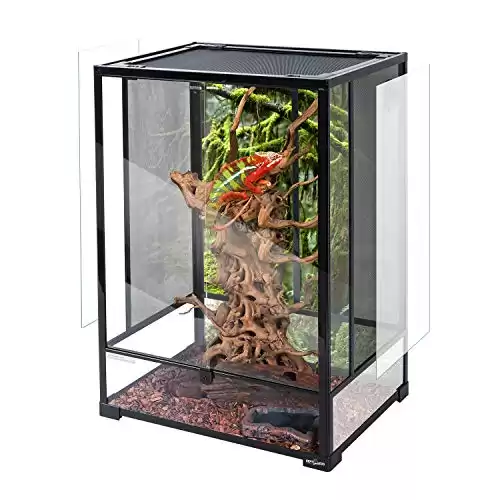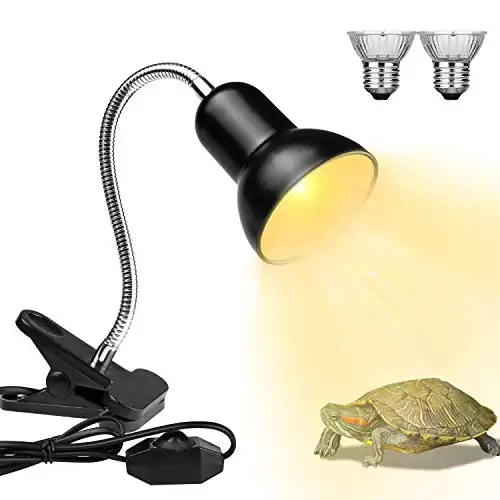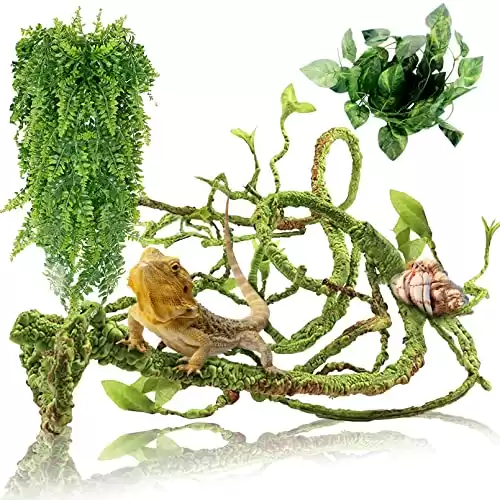Oustalet’s chameleons are not only stunning but also known for their inquisitive personality and playful quirks.
In this article, we’re going to take you on a journey into the world of these captivating creatures, revealing their fascinating behaviors, incredible adaptations, and what it’s like to have one of these charismatic reptiles as your own exotic companion.
Let’s jump right in!
How Do Oustalet’s Chameleons Look?

Oustalet’s chameleons, scientifically known as Furcifer oustaleti, are truly stunning chameleons.
These gentle giants are among the largest species of chameleons on the planet. Measuring in at around 20 to 24 inches (50-60 centimeters) in length, they certainly make a statement in the world of reptiles.
Additionally, Oustalet’s chameleons are masters of disguise, sporting a range of colors that can transition from brown to green to blue.
But here’s the fun part: these colors aren’t just for show! Their shield-like casque on top of their head can also change color, adding a touch of chameleon magic to their appearance.
If you look closely too, you’ll notice a distinctive ridge running from the end of their snout to their eyes, another smaller ridge from the eye to the back of their neck, and a row of triangular spines adorning their back all the way to the tip of their tail.
Check out their toes while you’re at it! Oustalet’s chameleons have a unique arrangement of toes, with three on the outside and two on the inside for their back feet (known as zygodactyl toes) and the opposite for their front feet.
This clever toe setup helps them grip branches with precision as they navigate their evergreen forest or deciduous forest habitats.
Where Do Oustalet’s Chameleons Live?
These captivating creatures are true natives of Madagascar.
Oustalet’s chameleons are endemic to Madagascar, which means they’re found nowhere else on Earth. This island nation in the Indian Ocean is their exclusive playground, and they’ve adapted beautifully to its diverse landscapes.
Another remarkable thing about these chameleons is their ability to thrive in various habitat types within Madagascar.
From evergreen forests with lush vegetation to deciduous forests with their unique charm, Oustalet’s chameleons have made themselves at home.
They’re also known to inhabit areas with native shrubs, where their remarkable camouflage skills come in handy.
What Is the Ideal Captive Habitat for Oustalet’s Chameleons?
Given that Oustalet’s chameleons can reach an impressive two feet in length as adults, it’s crucial to provide them with ample space.
A single adult should reside in a screened enclosure that’s at least 4 feet tall, 3 feet wide, and 3 feet deep. Taller enclosures are preferred to accommodate their arboreal nature.
- Multiple options for terrarium heating
- Provides extra space to add decor such as ledges
- Wire inlets allow for easy organization of light and thermometer cords
- Has a lot of vertical space that might not be useful to a ball python
- Not as budget-friendly as other options
Note that indoor enclosures need appropriate lighting. Install a dome light with an incandescent bulb to create a warm hotspot.
Additionally, reptile-specific UVB fluorescent lights placed on top of the enclosure are essential for their well-being. These lights help simulate the natural sunlight they would receive in Madagascar.
To combat dehydration, especially in hot and dry regions, consider using a cool-mist
Make sure to also include broadleaf evergreen plants or trees to provide shade, protection from temperature extremes, and a sense of security. Sturdy branches for perching are a must, as these chameleons love to climb.
Maintain an enclosure temperature that can safely reach about 90℉ too, as long as the humidity also rises appropriately. Remember that dry heat can be more harmful than humid heat. Always monitor your chameleon’s behavior for signs of discomfort.
Be cautious when selecting a substrate as well. Some materials can get caught on a chameleon’s tongue, leading to injury.
If you choose to use a substrate, paper toweling is a safe option. Potting soil can be used for gravid females, especially if you provide a dedicated egg-laying site.
What Are the Ideal Tank Mates for Oustalet’s Chameleons?
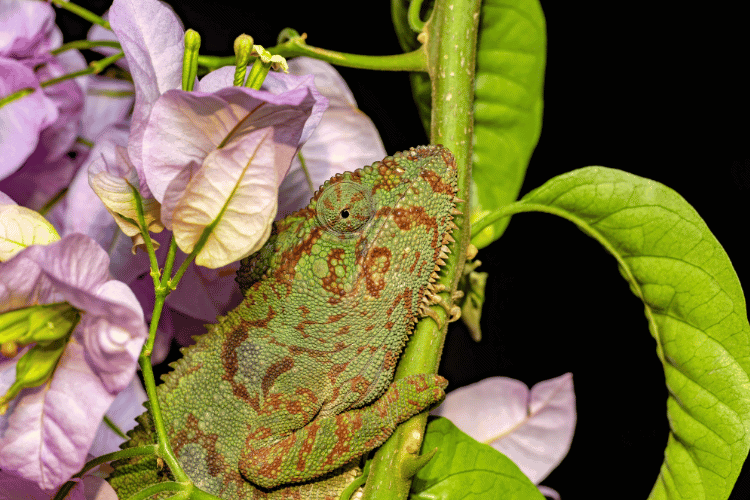
When it comes to Oustalet’s chameleons, it’s important to understand that these gentle giants often prefer that solo life.
Chameleons, in general, are known for their territorial and sometimes aggressive behavior.
Oustalet’s chameleons are no exception to this rule. They tend to perceive other chameleons as potential threats and may not play nice when sharing their space.
Given their territorial instincts, it’s typically best to keep Oustalet’s chameleons in their own enclosures, ensuring their comfort and well-being. This way, you can focus on providing them with the best care and attention they deserve.
What Are the Feeding Habits of Oustalet’s Chameleons?
These charming reptiles have a penchant for large insects, which form the core of their diet.
Crickets, mealworms, and other standard insect fare are on the menu. In the wild, they’ve even been known to indulge in delicacies like large hissing cockroaches and paper wasps – an impressive display of their hunting skills.
Other food items in their culinary repertoire might include some fruits, small birds, and reptiles.
As with many aspects of their care, the feeding habits of Oustalet’s chameleons change as they grow.
Juveniles have hearty appetites and benefit from daily feedings. Providing 3-5 appropriately sized insects per meal keeps their energy levels up.
However, as these gentle giants mature, their appetite decreases, and adult chameleons can be comfortably switched to feeding every other day.
To ensure their nutritional needs are met, it’s advisable to dust their prey items with supplements such as
What Is the Temperament of Oustalet’s Chameleons?
When it comes to temperament, Oustalet’s chameleons have their unique charm, but they aren’t your typical cuddly companions. These reptiles are more suited for observation rather than hands-on interaction.
That’s because Oustalet’s chameleons are known for their reserved and solitary disposition.
They’re most content when they don’t have to interact with humans, and they don’t seek out affection or companionship in the way that dogs or cats might. They thrive in their own world, observing their surroundings with curiosity.
While some chameleon species are more tolerant of handling, Oustalet’s chameleons tend to be sensitive. They often perceive humans as larger creatures, which can trigger stress.
Over time, they may become accustomed to your presence, but they may never fully embrace handling.
If you do wish to handle your Oustalet’s chameleon, it’s essential to proceed with caution and respect their boundaries. Here are some precautions to keep in mind:
- Gentle Approach: When handling, be gentle and slow. Avoid sudden movements or loud noises that might startle them.
- Short Sessions: Keep handling sessions brief to minimize stress. A few minutes at a time is usually sufficient.
- Infrequent Handling: Limit handling to necessary situations, such as health checks or enclosure maintenance. Avoid excessive handling, which can cause undue stress.
What Are the Common Health Issues for Oustalet’s Chameleons?
While Oustalet’s chameleons are relatively hardy for their species, they can still face health concerns common to chameleons in general.
These include conditions such as gout, bone disorders, and kidney failure. It’s essential to monitor their behavior and physical condition regularly.
One particular health issue that can affect Oustalet’s chameleons more significantly than other chameleons is parasitic infection.
Due to their larger size, they may harbor a higher parasitic load, making it challenging to fight off these invaders. Wild-caught chameleons are especially prone to parasitic infections.
If you suspect parasitic infestation, it’s crucial to seek veterinary care promptly.
Like many reptiles, Oustalet’s chameleons can experience stress-related illnesses. Sudden changes in their environment, handling, or inadequate husbandry practices can lead to stress.
To minimize stress-related issues, maintain a stable and suitable environment for your chameleon.
Other important care practices to keep in mind include:
- Regular Health Checks: Monitor your chameleon’s behavior and appearance for any signs of illness, such as lethargy, changes in appetite, or unusual colors.
- Proper Husbandry: Maintain consistent temperature and humidity levels in their enclosure. Ensure they have access to clean water and a balanced diet.
- Find a Reptile Vet: Locate a reputable veterinarian with expertise in reptile care. Regular check-ups can help detect and address health issues early.
What Are the Lifespan and Size of Oustalet’s Chameleons?
Oustalet’s chameleons are known for their impressive size and moderate lifespan.
In captivity, these captivating creatures typically live for approximately 5 to 8 years when provided with proper care.
As mentioned, they’re also one of the largest species of chameleon, with a maximum total length, including their tail, reaching up to 24 inches (roughly 60 cm).
What Are the Breeding Habits of Oustalet’s Chameleons?
Breeding these magnificent chameleons can be fascinating, but it requires careful planning and understanding of their reproductive behaviors.
To initiate breeding, introduce a female to the male’s enclosure and allow them several days together. Monitor their behavior closely; if any aggression occurs, separate them temporarily and try again after a few days.
Remarkably, a single breeding session can provide a female with enough sperm to produce multiple clutches of eggs. This unique sperm retention allows for future viable clutches even in the absence of a male.
Approximately three to four weeks after copulation, you can palpate the female for eggs. Gently massage her abdominal wall, and if she is gravid, you’ll feel eggs the size of jelly beans. Restless behavior, such as pacing, is often a sign that she’s ready to lay her eggs.
To encourage successful egg laying, ensure that females always have access to suitable egg-laying sites within their enclosures.
Alternatively, you can use an egg depository, such as a 30-gallon trash can filled with damp potting soil. This allows them to dig tunnels for egg deposition.
A female Oustalet’s chameleon typically lays 30 to 40 eggs per clutch, repeating this process three or four times a year.
Once the eggs are laid, they should be placed in a container with dampened vermiculite for incubation. Maintain a temperature range of 68℉ to 74℉ for nine to 12 months.
Simulate a spring rain by adding water after seven months. Regularly check temperature and moisture levels during incubation.
After incubation, hatchlings may be hearty eaters, often consuming fruit flies or pinhead crickets. It’s advisable to separate them into individual enclosures within a week or two if possible.
Are There Legal Considerations for Owning an Oustalet’s Chameleon?
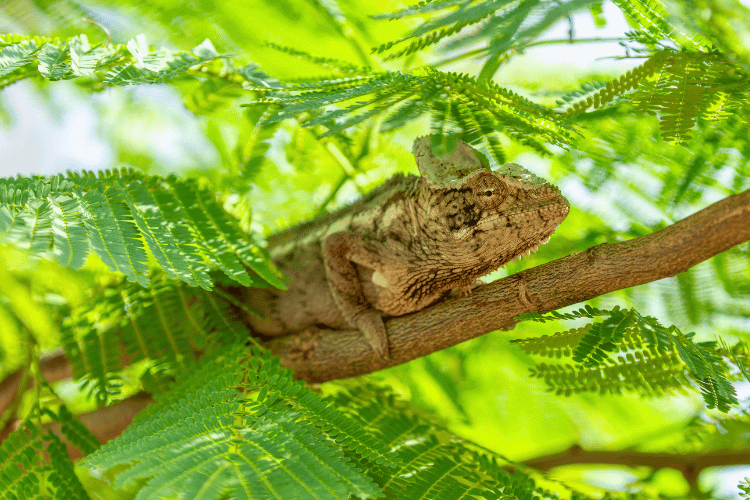
In most regions and states, Oustalet’s Chameleons can be legally kept as pets, bred, and sold.
However, there’s often a requirement for a permit or CITES (Convention on International Trade in Endangered Species of Wild Fauna and Flora) papers to ensure responsible ownership and trade.
It’s essential to note that a wild collection of chameleons, including Oustalet’s Chameleons, is typically illegal in many places.
Certain chameleon species are protected under wildlife conservation laws, making it unlawful to take them from their natural habitats.
Additional Resources
- Books:
- “Chameleon Care: The Complete Guide to Caring for and Keeping Chameleons as Pets” by Pet Care Professionals
- Forums:
- Chameleonforum.com
- OurReptileForum.com
Case Study
Check out Klaus – a red-head male Outstalet’s chameleon that Sean spotted on one of his trips in Madagascar. Interestingly, Klaus took a liking to Sean almost immediately!
FAQs
What is the behavior of the Oustalet’s chameleon?
Oustalet’s chameleons are known for their reserved and solitary behavior. They’re not typically affectionate or social with humans and thrive when left to observe their surroundings.
How do you take care of an Oustalet chameleon?
To care for an Oustalet’s chameleon, provide a large, well-maintained enclosure with proper temperature and humidity levels. Offer a varied diet of insects and maintain a stable environment to minimize stress. Regular vet check-ups are essential.
What is the largest chameleon in Madagascar?
The largest chameleon in Madagascar is the Oustalet’s chameleon (Furcifer oustaleti), known for its impressive size, with some individuals reaching up to 24 inches in length.
Equipment Needed
- Enclosure (screened or meshed)
- Heating source (ceramic heat emitter or
heat lamp ) - UVB fluorescent lighting
- Thermometer/hygrometer
- Basking perch or branches
- Substrate (potting soil for egg-laying, paper towel for young chameleons)
- Watering system (dripper or misting system)
- Live plants for enrichment
- Reptile-safe supplements (calcium and vitamin supplements)
- Insect feeder source (crickets, mealworms, etc.)
- Enclosure cleaning supplies (non-toxic disinfectant)


